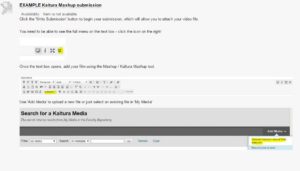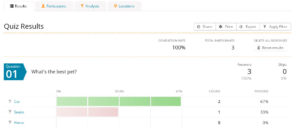Busy staff often complain – with justification – that training isn’t available when they need it. Learntech are always looking for better ways to make training easier to access and, as part of our improvements for 2015, are starting to introduce ‘pop-up training’ options. These are sessions on topics suggested by small groups of staff who are able to spare around an hour at a time on a date to suit themselves. Once we have been able to arrange a trainer and the resources, we will offer more places to other members of staff through School managers and the staff Facebook group. This will be at relatively short notice – maybe as little as a week – but we hope that this option will prove popular.
Panopto was the subject of our first full session – requested by three members of staff, we actually saw 12 staff attend and have created an online resource for staff unable to attend as a result. You can access the Panopto training session here, with a Podcast version available if your browser or device has difficulty displaying that content. Producing a Panopto recording of a Panopto recording is a bit more complicated than just creating a Panopto recording, but the attendees got a lot out of the session and were contemplating some novel uses. The ability to collectively share notes between students and instructors was a feature many thought should be more widely used.
If you have any similar training needs and can arrange for at least two staff members to attend, we will be delighted to do something similar for you. Contact your School Learning Technologist or mail us at learntech@northampton.ac.uk with your requirements, numbers and possible dates.
![]() Clear signposting for learners is really important but getting a consistent style to a site or learning unit can be difficult. Google have released 750 icons as a Creative Commons Attribution (CC-BY) resource that provides a large number of formats and sizes. You can download it from https://github.com/google/material-design-icons/releases – this is a big file though, over 50MB.
Clear signposting for learners is really important but getting a consistent style to a site or learning unit can be difficult. Google have released 750 icons as a Creative Commons Attribution (CC-BY) resource that provides a large number of formats and sizes. You can download it from https://github.com/google/material-design-icons/releases – this is a big file though, over 50MB.
Although font format is missing from this package, Sergey Kupletsky has created one that you can use if you prefer that approach (most modern professional web sites use this method nowadays).
The combination of all these formats should mean that it is relatively easy to create websites, learning units and even printed material that follows the same design.
(First published in the Nile External resources site)
The report for this year’s mobile survey has now been published where we look at the way that mobile devices, apps and interactions are used and carried out at Northampton. There were 322 respondents who took the opportunity to let us know their thoughts on the University’s mobile provision and any developments that they would like to see.
The report provides a brief summary of the main findings of the survey, including an overview of technology ownership among staff and students, trends in mobile use, facilities on campus (WiFi etc), and feedback on the iNorthampton app (which you can find in the App Store, Play Store and on the web).
You can read the report here: Mobile Survey report 2014/15 (PDF, 1024KB)
Karl Flowers, Senior Lecturer, Institute for Creative Leather Technology assesses his students through presentations and has often found that it is difficult to schedule face-to-face time slots where all the required parties can make it. Allowing his students to independently record their presentations and submit them through NILE’s video streaming tool, Kaltura, overcomes scheduling issues, enables more use of technology for the students and enables sharing good practice between year groups.
In 2010, Roshni Khatri presented on students perceptions of online audio and online text based feedback. Her experiences on feedback were also further disseminated in the Submission and Grading Electronically (SaGE) working group on 17th December, 2014 as they were felt to be still relevant to current cohorts.
Roshni indicated that the majority of students preferred the audio feedback when compared to the online feedback.
Students commented that:
- ‘The online written feedback was visual and suits my learning style.’
- ‘I heard my name and I paid attention!’
- ‘really helpful for me as I am able to go over the proposal and know which bits you are explaining about. I find this more helpful than having written feedback.’
The presentation noted benefits and problems with the process and made suggestions for further work.
 Although we suggest using the Media Gallery on NILE for students to submit work to, there are a couple of drawbacks. You would need to add feedback and marks through a Grade Centre column and students cannot see their submitted work in the media gallery, which has led to a few anxious calls to the LearnTech helpdesk.
Although we suggest using the Media Gallery on NILE for students to submit work to, there are a couple of drawbacks. You would need to add feedback and marks through a Grade Centre column and students cannot see their submitted work in the media gallery, which has led to a few anxious calls to the LearnTech helpdesk.
The alternative is to use a standard Blackboard Assignment (not Turnitin) and allow students to use the Kaltura Mashup tool – which is part of the text box editor. This creates a Grade Centre column and students will have more confidence that they have submitted their work.
It does require clear guidance though so we have created a basic explanation (with screenshots that will work in any module), that you can paste into the description text box (use the HTML editor) to get you started.
Images and interactivity encourage students to explore content more willingly that a list of links and anything that can facilitate students to generate and share content themselves outside of the rather clunky discussion boards and blogs within NILE is always welcome.
thinglink is a free picture annotation tool website that allows content to be linked to external resources and then be embedded in your NILE site or blog. There are also editors available as IOS or Android apps.
Possible uses are as a ‘visual portal’ for students to access further information and resources or – if the thinglink is set to public – as a shared activity where students can add links and annotations to a picture as a class or as part of a group.
You can find more details and try using example thinglinks in this NILEX review.
Thanks to Belinda Green for spotting the usefulness of this app in Education and sharing.
 We’re well into assignment season and support calls are beginning to increase in relation to missing assignment submission points, incorrect settings preventing students from uploading one or more versions, apparently missing assignment submission in Grade Centre, grades being released too early (or never) and scores instead of letter grades being given to students.
We’re well into assignment season and support calls are beginning to increase in relation to missing assignment submission points, incorrect settings preventing students from uploading one or more versions, apparently missing assignment submission in Grade Centre, grades being released too early (or never) and scores instead of letter grades being given to students.
While it might be tempting to blame the computer*, it’s usually just being a little rusty that’s at the root of the problem. Please take a few minutes to remind yourself of the simple things to do before and after marking to avoid problems by looking at the SaGE survival guide.
NILE isn’t without its problems, but we must be honest with students if we are to be able to interpret their feedback on this critical part of their student experience.
* and posting this in an announcement!
 Learntech have been examining the world of free online polling tools this week in response to a number of requests. While there are several alternatives with different strengths an weaknesses, Polldaddy stands out as a flexible tool to use in a variety of situations – as a brief informal piece of formative assessment, a survey/poll or just feedback on a piece of content or activity. These items embed very well within NILE. There is a fuller description of Polldaddy on the NILE External Tools blog.
Learntech have been examining the world of free online polling tools this week in response to a number of requests. While there are several alternatives with different strengths an weaknesses, Polldaddy stands out as a flexible tool to use in a variety of situations – as a brief informal piece of formative assessment, a survey/poll or just feedback on a piece of content or activity. These items embed very well within NILE. There is a fuller description of Polldaddy on the NILE External Tools blog.
It requires an email registration on the WordPress.com site, with which it is also tightly integrated.
 Although Staff have access to Panopto to record their presentations, students have had to do things like embedding audio into PowerPoint to create multimedia presentations until now.
Although Staff have access to Panopto to record their presentations, students have had to do things like embedding audio into PowerPoint to create multimedia presentations until now.
SlidesLive can work in a very similar way to Panopto – download the recording software (for Mac and Windows), record the presentation, upload it and make some editing changes. It is slightly different in that it converts each slide to an image, the advantage being that it’s possible to replace or remove a slide using the online editor. It’s also possible to add a second ‘stream’ by using a video clip from YouTube that can be viewed alongside the slide images – the viewer can adjust the relative sizes of those two pictures.
There’s nothing to stop you adding a YouTube video directly in the online editor, then adding a number of images (these could be captions or even a transcript) which you can synchronise to the video. You’re not obliged to just capture PowerPoint, the recording of the slides is just a screen capture, so you can use other presentation software or just capture a screen (just one screen if you have two).
In its simplest form, most students would have very little difficulty in creating a basic presentation. The down side is that although uploaded presentations can be made unlisted, they cannot be downloaded so are unsuitable for summative assessments. However, presentations can be made public, perhaps as part of a portfolio or an online CV. The slide/video combination also opens up the possibility of more creative uses – critiquing someone’s video presentation or interpreting the content. 
You can find a video/slides example here. SlidesLive does require users to register using a simple email – as ever, we’d suggest avoiding the Facebook login option.
Recent Posts
- Spotlight on Excellence: Bringing AI Conversations into Management Learning
- Blackboard Upgrade – December 2025
- Preparing for your Physiotherapy Apprenticeship Programme (PREP-PAP) by Fiona Barrett and Anna Smith
- Blackboard Upgrade – November 2025
- Fix Your Content Day 2025
- Blackboard Upgrade – October 2025
- Blackboard Upgrade – September 2025
- The potential student benefits of staying engaged with learning and teaching material
- LearnTech Symposium 2025
- Blackboard Upgrade – August 2025
Tags
ABL Practitioner Stories Academic Skills Accessibility Active Blended Learning (ABL) ADE AI Artificial Intelligence Assessment Design Assessment Tools Blackboard Blackboard Learn Blackboard Upgrade Blended Learning Blogs CAIeRO Collaborate Collaboration Distance Learning Feedback FHES Flipped Learning iNorthampton iPad Kaltura Learner Experience MALT Mobile Newsletter NILE NILE Ultra Outside the box Panopto Presentations Quality Reflection SHED Submitting and Grading Electronically (SaGE) Turnitin Ultra Ultra Upgrade Update Updates Video Waterside XerteArchives
Site Admin



